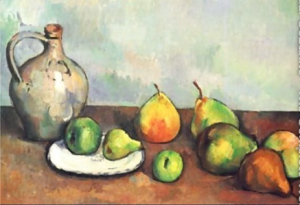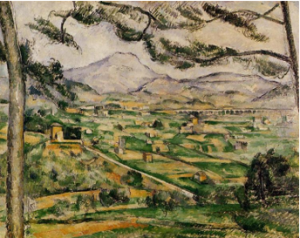Paul Cezanne was a French painter of the mid-19th century to early 20th century who transitioned from the Impressionist movement. He was fondly called the “Master of Aix” because of his hometown Aix-en-Provence, in southern France. He is mainly remembered for initiating the passage from Impressionism to the radically different 20th-century avant-garde movements, notably Cubism and Fauvism.
What the newer movements found attractive about Cezanne’s work was his unique style of constructing images as if he were building rather than painting. While Impressionists employed subtle brushstrokes, Cezanne used methodical brushstrokes that reflected an underlying focus on form that seemed architectural. While speaking about Cezanne’s influence on their work, art giants Picasso and Matisse referred to him as “the father of us all.”
Cezanne’s constructive composition characterized his career, and even though it was unpopular at the time, the artist maintained it. The technique conveys his vigorous study of subjects and competence in handling complex optics. In this article, we look at the artist’s career and some of Paul Cezanne drawings .
About Paul Cezanne
The artist was born on January 19, 1839, in Aix-en-Provence, France. Cezanne was the only son of a prominent banker with lofty dreams for his son, but unfortunately, those didn’t include art. However, his father’s disapproval didn’t dissuade Cezanne, and after three years of law college, he left for Paris to begin his career as an artist in 1861.
On getting to Paris, Cézanne enrolled at the Académie Suisse, but after five disappointing months, he returned to Aix. A year later, he returned to Paris with better determination to stay and succeed. He joined the city’s Impressionist circle, where he met impressionist artist Camille Pissaro. The older impressionist mentored Cezanne until a decade later, when both artists became contemporaries.
Painter Cezanne did not find the success he came searching for in Paris. Before he posthumously became a celebrated artist, his art was heavily criticized by Parisian society. His association with the Impressionists naturally brought him some of their ill luck, and he was even more peculiar because his methods differed from the Impressionists. Although he continued to paint, the rejection drove him to isolation.
His relentless productivity eventually paid off as even though he was in solitude, a new wave of younger artists discovered and admired his works. They aligned with many of his idiosyncrasies and hailed him as a revolutionary. They traveled to watch the production of many of the best Paul Cezanne drawings.
Curtain Jug and Fruit Bowl

Still life, jug and fruits – Paul Cezanne
Rideau, Cruchon et Compotier (Curtain, Jug and Fruit Bowl) is an oil painting produced circa 1893 and 1894. It is a still-life genre painting that expresses Cezanne’s curiosity about form and symmetry in objects, mainly fruit.
He carefully arranged his still-life subjects to manipulate perspective and optics in art constructively. The fact is also actual in this painting, a depiction of an earthenware jug and fruit platter on a wooden table. Some fruits lie scattered across the table as well as along the folds of the white cloth on it.
In 1999, the painting was bought by billionaire Ken Griffin for an impressive $60,000,000 at a Sotheby’s auction, making it the most expensive still-life painting in art history. Later that year, Griffin resold it to art collector Steve Wynn for an undisclosed amount.
The Card Players
The Card Players is from Cezanne’s late-period series, which consists of 5 oil paintings depicting men playing cards. The paintings differ in size, setting, and number of players, but the card-playing theme is a constant factor in all 5.
Critics regard the series as a pivotal piece in Cezanne’s career, a precursor to the notable works from his final years from the late 1890s to his death in the early 1900s. It depicts men smoking pipes and absorbed in their game of cards over wooden tables.
In 2011, the Qatari royal family purchased one of the paintings for $250,000,000. After that, it remained the world’s priciest painting until it was surpassed in 2017 by Da Vinci’s Salvator Mundi.
Large Bathers
The Bathers is one of the famous series by the famous painter Cezanne. Large Bathers (Les Grandes Baigneuses) is the series’s largest and most famous painting. It is also considered Cezanne’s finest work and a true masterpiece of modern art.
The painting depicts nude female bathers in abstract style. Their figures form a triangle with the trees and river in the background. Also in the background is a blue sky with white clouds and an outline of green foliage in the distance.
The painting was produced during Cezanne’s late period, circa 1898–1905, and was unfinished when he died in 1906. It currently resides at the Philadelphia Museum of Art, USA.
Mont Sainte-Victoire

Mont Sainte Victoire – Paul Cezanne
Mont Sainte-Victoire is the third Cezanne series on the list. The series features 30 oil and watercolor depictions of a mountain range of the saw name in southern France and overlooking Cezanne’s hometown of Aix-en-Provence.
The mountain range became one of Cezanne’s most repeated motifs. In an 1878 letter to his author friend Émile Zola, he described the limestone mountain as a “beau motif,” meaning beautiful motif. However, he diversified each painting in order not to seem repetitive. From changes in perspective and lighting to other compositional adjustments, he changed something about each depiction.
The creation process spanned two years, from 1904 to 1906, when painter Cezanne died from Pneumonia complications at age 67. Today, the series is housed at the Musée d’Orsay, Paris.
Conclusion
Paul Cezanne’s career demonstrates the importance of choosing authenticity over conformation in the world of art. Despite the criticism, his dogged adherence to his craft set him apart as the trailblazer he came to be respected as. His career is also marked by his evolution as an artist, making it challenging to peg his career as one thing. Nonetheless, his famous catalog highlights his prowess as an iconic artist.
Bob Andrews is a content editor for Landscape Insight, With a background in journalism, Bob brings a unique perspective to his role as he oversees the creation and publication of a wide range of content, including articles, podcasts, and videos. You can reach Bob at – [email protected] or by Our website Contact Us Page.








